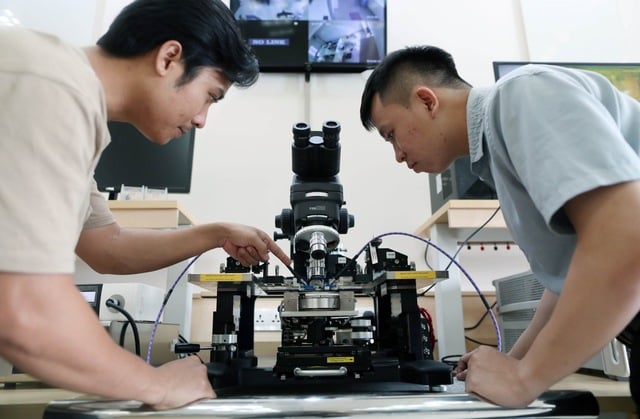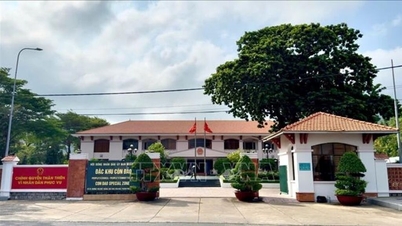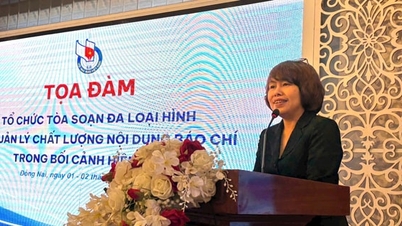Associate Professor Dr. Ho Dac Nguyen Nga believes that the value of a university brand can be greater than all the material values of that school combined. When merging, many brands like that will be lost. Will the values created from the merger be large enough to compensate?

Associate Professor, Dr. Ho Dac Nguyen Nga
PHOTO: NVCC
WILL CREATE SCHOOLS OF TOTAL STRENGTH
How do you assess the urgency of arranging and restructuring the current university system in Vietnam?
Associate Professor, Dr. Ho Dac Nguyen Nga : Vietnam is preparing to reorganize and restructure public university education institutions. Specifically, it will merge some schools together and dissolve unqualified university education institutions. From there, it will clearly distinguish the difference between the elite university system and the college system that focuses on practical vocational training. In addition, the intermediate level will be eliminated, ensuring streamlined, unified and effective management.
The spirit of these changes, in my opinion, is good and necessary. Some universities with substandard quality should be dissolved to free up resources to do other things for society. The clear separation of the elite university system and practical colleges will clarify the career path for students to choose. Avoid the situation of "half-teacher, half-worker" training, which is not suitable for the needs of the current and future labor market.
In addition, many universities in Vietnam are specialized universities. Merging into multidisciplinary institutions will create schools with more overall strength. Merging similar fields will also have the advantage of increasing scale, reducing fragmentation in development investment and simplifying the choice of training programs for students.

Study and research activities at the Microcircuit and High Frequency System Laboratory, University of Technology (Ho Chi Minh City National University)
PHOTO: NGOC DUONG
Eliminating the middle level, ensuring streamlined, unified and effective management is very important for Vietnamese universities. Many universities are currently subject to overlapping management with many different regulations. This leads to increased management costs and missed development opportunities. Many universities have many opportunities for better development, but are stuck in these overlapping management mechanisms and cannot develop.
So is the policy of arranging and restructuring Vietnamese universities in line with the general trend in the world , specifically in the US, sir?
These arrangements have some similarities with the current trend in universities in the US. In recent times, the administrative apparatus of universities in the US has been bloated, becoming a problem for education. The administrative costs of many schools amount to 50-75% of total costs, leading to a reduction in investment in matters directly related to education and research. Meanwhile, tuition fees have increased rapidly, becoming a burden on society. Many schools in the US have begun to cut down their administrative apparatus and even merged with each other to reduce the administrative apparatus in order to increase direct investment in education and research.
However, universities are complex organizations. Mergers and acquisitions pose many challenges that, if not overcome, may result in less than desirable outcomes.
5 NOTES WHEN ORGANIZING THE VIETNAMESE UNIVERSITY SYSTEM
In your opinion, how should the restructuring of Vietnamese universities be carried out? What factors should be focused on so that it is not just a mechanical arrangement?
I have witnessed a merger of universities in Vietnam with not so good results. This time, the merger will be carried out on a national scale, hopefully Vietnam will do things differently in some aspects.
Firstly, the merger must lead to streamlining the management apparatus and simplifying laws and regulations. Focusing resources on research and direct training. Creating an open mechanism for schools to develop.
Second, mergers must create a combined strength greater than the strength of the individual schools. One way to do this is to create interdisciplinary training programs based on the merger of specialized schools. For example, to train technology entrepreneurs, we need interdisciplinary training programs between science - technology and business administration. Allowing students in one major to take additional classes in other majors also creates workers with the ability to work in other fields, an important ability today.
Interdisciplinary research is also a necessary strength for this era. For example, drug development using artificial intelligence (AI) requires people who can research in both drug development and AI, or the collaboration of a drug development research group and an AI research group. This would be much more convenient if we had both fields in the same university.

It is necessary to consider the brand factor when implementing the arrangement and merger of university educational institutions.
Photo: Pham Huu
Third, the merger must take into account the cultural factor. Two different universities will largely have different working cultures. Merging to work together requires a careful roadmap, starting with understanding how different the two cultures are and what needs to be done to harmonize the cultures when merging. Many cases of organizational mergers look great on paper but when implemented, they fail because of this problem.
Fourth, be careful about favoritism. When two schools merge, the head of one school will tend to favor people and majors from that school over those from the other. This leads to skewed investment and internal tensions, which negatively affect the common work.
Fifth, it is necessary to consider the brand factor. Long-standing universities have built very valuable brands such as Polytechnic, Foreign Trade... Many professors come to work for that school because of the brand. Many students choose to study at that school also because of the brand. Many employers select graduates to work also based on the brand. Many international organizations and universities cooperate with that school also because of the brand. The value of a university brand can be greater than all the material values of that school combined. When merging, many brands like that will be lost. Will the values created from the merger be large enough to compensate?
I hope that this time if we do, we need to consider the above 5 things carefully to ensure that our country's education advances to a new level.
Source: https://thanhnien.vn/sap-xep-truong-dai-hoc-phai-can-nhac-yeu-to-thuong-hieu-185251007212900153.htm





![[Photo] Prime Minister Pham Minh Chinh chairs the 16th meeting of the National Steering Committee on combating illegal fishing.](https://vphoto.vietnam.vn/thumb/1200x675/vietnam/resource/IMAGE/2025/10/07/1759848378556_dsc-9253-jpg.webp)



































![[Photo] Super harvest moon shines brightly on Mid-Autumn Festival night around the world](https://vphoto.vietnam.vn/thumb/1200x675/vietnam/resource/IMAGE/2025/10/07/1759816565798_1759814567021-jpg.webp)



























































Comment (0)